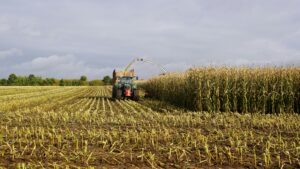Amid tough environmental regulations and rising sustainability issues, industries are now looking for new ideas on how to handle their wastewater. One of the most promising techniques in this area is anaerobic digestion. This technology not only treats industrial waste water but also generates renewable energy. As a result, anaerobic digestion can be considered an appealing alternative for companies. It especially includes the ones that want to enhance their environmental performance by maximizing their operational efficiency. This article will explore the principles of anaerobic digestion for industrial wastewater solutions, its advantages, and challenges/future developments. So, let’s dive in.
The Basics of Anaerobic Digestion
Anaerobic digestion is a complex biological process occurring in the absence of oxygen. Various microorganisms decompose the organic matter in it. A solid understanding of how biomethanation works is crucial for effectively integrating it into an industrial wastewater solutions system. That’s why let’s consider this below:
- Hydrolysis
In the first stage, the process typically converts complex organic compounds like proteins, carbohydrates, and fats into simple molecules. It includes amino acids, sugars, and fatty acids. This phase is vital because it makes the organic matter ready for further bacterial degradation in later stages. For example, researchers have found hydrolysis as a rate-limiting step for some materials used in anaerobic digestion because of its slow speed.
- Acidogenesis
During the acidogenesis stage, acidogenic bacteria further decompose hydrolysis products. They transform simple sugars, amino acids, and long-chained fatty acids into volatile fatty acids (VFAs). This is namely acetic acid, propionic acid, and butyric acid respectively by these microorganisms. Furthermore; small amounts of alcohol alongside Carbon (IV) oxide gas together with hydrogen gas are formed in the course of this phase. Acidogenesis occurs comparatively much faster than all other stages within the anaerobic digestion process.
- Acetogenesis
During this phase, acetogenic bacteria convert the acidogenesis products into acetic acid, hydrogen, and carbon dioxide. These bacteria coexist with methanogens, which handle the final step of anaerobic activity, characterized by methane production. Methanogens must utilize the hydrogen produced at this stage to prevent high levels of it from inhibiting acetogenesis.
- Methanogenesis
During the last stage, methanogenic archaea convert acetogenic products into biogas. It is made of methane and carbon dioxide. There are two primary pathways through which Methane comes into being:
- Acetoclastic methanogenesis which directly transforms acetic acid into methane and CO2;
- And hydrogenotrophic methanogenesis which utilizes hydrogen and CO2 to create methanol.
It is an important step in obtaining biogas from organic waste matter especially since it highly depends on pH value as well as temperature. Usually, the resultant biogas contains about 50-75% CH4 and 25-50% CO2 together with traces of other gases.
Benefits of Anaerobic Digestion for Industrial Wastewater Treatment
Anaerobic digestion has many pros when compared to the conventional waste management process, thus making it appealing for industries that wish to implement sustainable practices.
Minimization of Waste and Resource Usage
This technique helps remove a huge amount of waste produced in water by eliminating the difficult organic ingredients in it. As such, the amount of sludges generated is reduced substantially. This results in significant recycling savings on its management. Even better, sewage contains several useful byproducts such as biogas, which is a renewable energy source. This resource recovery changes the nature of garbage from that of responsibility into something profitable in support of circular economy principles.
Generation of Energy and Savings
Biogas, produced through anaerobic digestion, stands out as the most important renewable energy source, offering numerous advantages over conventional sewage water treatment methods. This biogas primarily consists of methane and carbon dioxide, which can come in use for electricity generation, heating, or upgraded to biomethane for use as automotive fuel. By producing their power, industries have been able to save lots on expenses since they do not have to depend on any outside sources for power anymore. This also reduces greenhouse gas emissions from industrial activities thereby helping in mitigating climate change impacts So, this is one of the ways how anaerobic digestion improves efficiency in industrial wastewater management
Lower Environmental Impact
Compared to aerobic methods, anaerobic digestion provides a more eco-friendly way of treating industrial wastewater. Because it does not need oxygen to be pumped into the system, it requires less energy input. As a result, it leads to low costs for operating and a reduction in carbon emissions. Furthermore, with the methane captured, anaerobic digestion helps in reducing greenhouse gas emissions as well. This is because it would otherwise be gone to the atmosphere if not captured. Moreover, the process also comes with less odor making it great for highly populated regions.
Challenges and Future Developments
Anaerobic digestion offers well-known advantages, but it also presents challenges that require attention for wider adoption and improved performance.
Overcoming Technical Hurdles
Maintaining the right conditions for microorganisms during anaerobic digestion is a major challenge. These include factors that affect the efficiency of these processes such as pH, temperature, and inhibitors presence that affects their efficiency. Current research on more efficient and robust bacterial communities as well as control systems aimed at improving stability and efficiency in anaerobic digesters is underway. There are efforts to enhance biogas purification technologies to promote bio-methane upgrading from raw earth methane more cheaply and easily for massive use purposes.
Incorporating alternative technologies
Integration of anaerobic digestion into other systems for industrial wastewater solutions and resource recovery is set to mark its future. For example, the anaerobic activity combined with membrane filtration can lead to better effluents targeted at water reuse. There are also attempts to combine anaerobic activity with algal culture where CO2 from biogas acts as fertilizer for growing algae that can be used later in the production of biofuels This integrated approach has huge potential for optimizing material recovery while minimizing wastes.
Spreading to new industrial domains
As technology evolves, there are chances to use anaerobic digestion in various industries. Researchers are trying to modify it for such industrial sectors that struggle with highly complicated wastewater compositions like textiles and petrochemicals. There is a possibility that this extension can greatly enhance the overall effect of anaerobic digestion. This is on treating industrial effluents and generating energy using renewable sources.
To Sum Up
Anaerobic digestion is transforming industrial wastewater solutions. This system can successfully treat high-strength organic wastewater and at the same time produce green energy. Additionally, technological advancements and better integration with other processes will make anaerobic activity more significant.
Join us in Frankfurt, Germany, for the Industrial Water & Wastewater Management Summit on September 26-27, 2024 to find out more about innovative solutions to wastewater treatment. It brings together industry leaders, researchers, and policymakers to discuss what’s new in industrial water management. Grab this chance to discover some of the most recent advancements in sustainable water usage strategies and state-of-the-art technologies for the industry. Register now for this landmark event!




